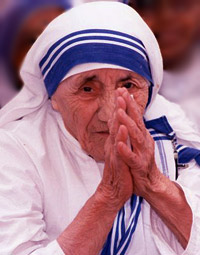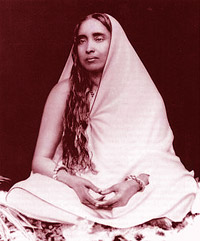Special Mother
Mother Teresa
Born as 'Agnes Gonxha Bojaxhiu', this compassionate girl grew up to
devote her entire life to the cause of mankind. Brought up as a
Roman catholic by her mother, Agnes developed a religious bent of
mind early on in her life and it drew her to charitable activities.
When only 18 years old, she left home forever to join the 'Sisters
of Loreto' as a missionary.
 She received her spiritual training in
Ireland and Darjeeling, India. It was in 1931, that the Mother took
the name of Teresa from the French nun Thérèse Martin, who was
canonized in 1927 with the title St. Thérèse of Lisieux. In 1937,
Mother Teresa took her vows. She taught for 20 years in Saint Mary's
High School in Calcutta, India. It is during this time that she
witnessed the poverty, suffering and misery of millions in India.
Moved by the pitiable sights that she encountered everyday, Teresa
decided to dedicate her whole life for the welfare of the poor and
acquired Indian citizenship in 1948. With the permission of Pope
Pious XII, Teresa became an independent nun in the same year and
began to live with the destitutes of Calcutta. She started to impart
education to street children and established a congregation called
the Missionaries of Charity - a charitable organization which was to
be the centre of all her activities with its branches spread in many
parts of the country. In 1950, she set up a care centre for the
patients of leprosy. Agnes' efforts received a great impetus in 1965
when Pope Paul VI put the Missionaries of Charity under his
protection and gave Mother the permission to expand her Order to
other countries. Within a few years, branches of
the Missionaries of Charity opened almost everywhere around the
world to care for the poor, lepers, the elderly, the blind and
people affected with sexual diseases like AIDS. Schools and homes
were also set up for the poor and abandoned children. Agnes' loving
touch began to be felt throughout the world and she came to be known
as "Mother
Teresa". Inspite of her reservations, the Nobel Peace Prize was
conferred on her in 1979, which she accepted on behalf of the
"poorest of the poor". She continued her noble deeds till death
snatched her away from us in August, 1997. The people of Calcutta
bid their mother a teary farewell and the world watched the live
telecast of the solemn funeral march dedicated to her. Despite not
being a mother in the biological sense, she was the "mother of all"
- indeed a special mother. Her divinity was honored on October 19,
2003 when she was beatified by Pope John Paul II.
She received her spiritual training in
Ireland and Darjeeling, India. It was in 1931, that the Mother took
the name of Teresa from the French nun Thérèse Martin, who was
canonized in 1927 with the title St. Thérèse of Lisieux. In 1937,
Mother Teresa took her vows. She taught for 20 years in Saint Mary's
High School in Calcutta, India. It is during this time that she
witnessed the poverty, suffering and misery of millions in India.
Moved by the pitiable sights that she encountered everyday, Teresa
decided to dedicate her whole life for the welfare of the poor and
acquired Indian citizenship in 1948. With the permission of Pope
Pious XII, Teresa became an independent nun in the same year and
began to live with the destitutes of Calcutta. She started to impart
education to street children and established a congregation called
the Missionaries of Charity - a charitable organization which was to
be the centre of all her activities with its branches spread in many
parts of the country. In 1950, she set up a care centre for the
patients of leprosy. Agnes' efforts received a great impetus in 1965
when Pope Paul VI put the Missionaries of Charity under his
protection and gave Mother the permission to expand her Order to
other countries. Within a few years, branches of
the Missionaries of Charity opened almost everywhere around the
world to care for the poor, lepers, the elderly, the blind and
people affected with sexual diseases like AIDS. Schools and homes
were also set up for the poor and abandoned children. Agnes' loving
touch began to be felt throughout the world and she came to be known
as "Mother
Teresa". Inspite of her reservations, the Nobel Peace Prize was
conferred on her in 1979, which she accepted on behalf of the
"poorest of the poor". She continued her noble deeds till death
snatched her away from us in August, 1997. The people of Calcutta
bid their mother a teary farewell and the world watched the live
telecast of the solemn funeral march dedicated to her. Despite not
being a mother in the biological sense, she was the "mother of all"
- indeed a special mother. Her divinity was honored on October 19,
2003 when she was beatified by Pope John Paul II.
Sri Sarada Devi
On 22nd December 1853, a saintly soul was born in a poor Brahmin
family in Jayrambati, a village adjoining Kamarpukur in West Bengal.
Little did the world know that this little baby girl would one day
become Sri Sarada Devi, the wife and spiritual consort of Sri
Ramakrishna, one of the greatest spiritual souls the world has ever
beheld.
 When only about six years old, she was married off (as was
the custom prevalent in India in those days) to Sri Ramakrishna.
However, she continued to live with her parents after marriage,
while Sri Ramakrishna lived a God-intoxicated life at Dakshineshwar.
When she turned 18, Sarada went to her husband who received her with
great affection, and allowed her to stay with him. But they lived
pure lives and Sri Ramkrishna is believed to have obtained her
wife's permission in following his spiritual path and staying away
from a sensual domestic life. Sri Sarada Devi smilingly encouraged
her husband and remained a virgin nun. Sri Ramakrishna accepted her
as his devoted wife and disciple and taught her how to lead a
spiritual life while discharging her household duties. He aroused
the universal Motherhood latent in her and taught her to look upon
his disciples as her own children. When Sri Ramakrishna passed away
in 1886, Sarada Devi went to Kamarpukur to live in seclusion. But
the disciples of Sri Ramakrishna brought her to Kolkata and many
spiritual seekers became her disciple. Sarada Devi made no
distinction between them and accepted all as her children
irrespective of caste, religion or race. Even those who had led
sinful lives were not turned away. She demonstrated her progressive
outlook in a conservative society when she accepted the Western
women disciples of Swami Vivekananda, one of her husband's greatest
disciples. All through her life, this divine lady lived like a
simple village mother, washing clothes, sweeping the floor, bringing
water from the pond, dressing vegetables, cooking and serving food.
In her own words, she lived to "manifest that Divine Motherhood in
the world" that Sri Ramakrishna had, the "maternal attitude (matri-bhava)"
that he possessed. For thousands of people including Swami
Vivekananda, she was the ideal woman and the "Holy Mother".
When only about six years old, she was married off (as was
the custom prevalent in India in those days) to Sri Ramakrishna.
However, she continued to live with her parents after marriage,
while Sri Ramakrishna lived a God-intoxicated life at Dakshineshwar.
When she turned 18, Sarada went to her husband who received her with
great affection, and allowed her to stay with him. But they lived
pure lives and Sri Ramkrishna is believed to have obtained her
wife's permission in following his spiritual path and staying away
from a sensual domestic life. Sri Sarada Devi smilingly encouraged
her husband and remained a virgin nun. Sri Ramakrishna accepted her
as his devoted wife and disciple and taught her how to lead a
spiritual life while discharging her household duties. He aroused
the universal Motherhood latent in her and taught her to look upon
his disciples as her own children. When Sri Ramakrishna passed away
in 1886, Sarada Devi went to Kamarpukur to live in seclusion. But
the disciples of Sri Ramakrishna brought her to Kolkata and many
spiritual seekers became her disciple. Sarada Devi made no
distinction between them and accepted all as her children
irrespective of caste, religion or race. Even those who had led
sinful lives were not turned away. She demonstrated her progressive
outlook in a conservative society when she accepted the Western
women disciples of Swami Vivekananda, one of her husband's greatest
disciples. All through her life, this divine lady lived like a
simple village mother, washing clothes, sweeping the floor, bringing
water from the pond, dressing vegetables, cooking and serving food.
In her own words, she lived to "manifest that Divine Motherhood in
the world" that Sri Ramakrishna had, the "maternal attitude (matri-bhava)"
that he possessed. For thousands of people including Swami
Vivekananda, she was the ideal woman and the "Holy Mother".
On 21 July 1920, the Holy mother left her mortal coils to be in
unison with the great divinity. But even about 100 years later, she
remains ever so bright in our hearts and her peaceful image
continues to be venerated in many Indian homes.


 Mother's Day
Mother's Day Passover
Passover Good Morning
Good Morning
